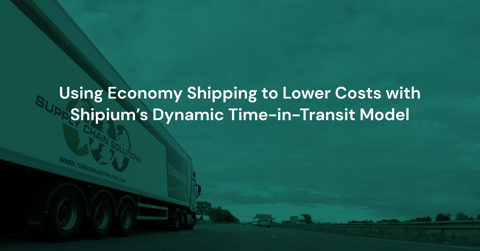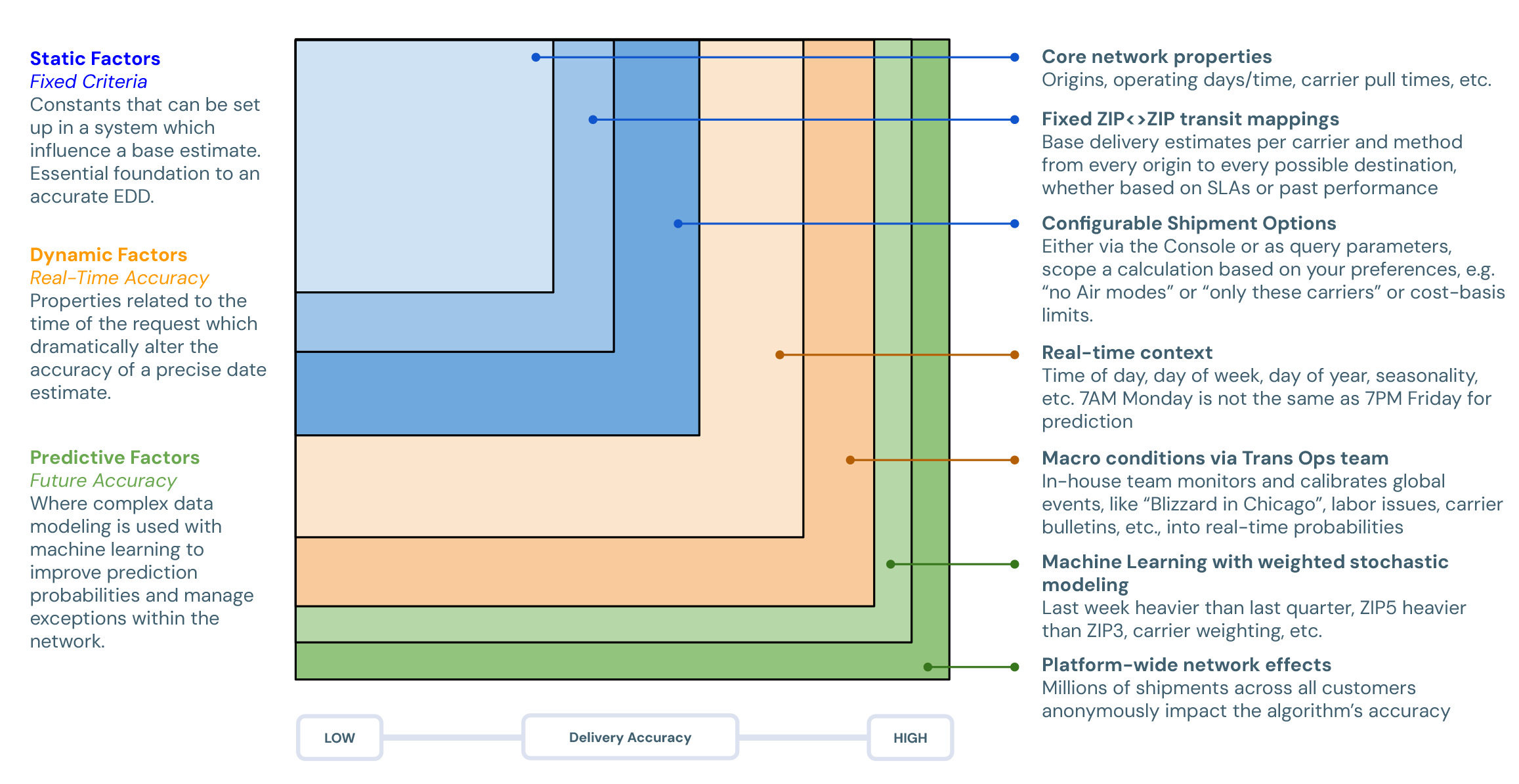How Choosing an Economy Shipping Method can Reduce Costs

Efficient and cost-effective shipping methods like UPS Mail Innovations, FedEx Ground Economy, and DHL Ecommerce enable you to diversify shipping options, increase margins or pass savings on to customers, improve the sustainability of shipping operations, and more.
Here’s the problem: because of the absence of service-level agreements (SLA) and general performance unpredictability, shippers don’t leverage these options as often as they could (or should). Shipments that are time-sensitive (“delivery by Thursday”, “deliver in 3-5 business days”) typically won’t flow to these cost-effective carrier services because shippers can’t know for certain when a shipment will be delivered. Legacy tech and DIY internal efforts simply don’t have the capabilities to send more volume to these services as a result.
The good news? One of the primary use cases for Shipium’s Dynamic Time-in-Transit Model is to create accurate EDDs for economic shipment options, effectively enabling you to establish a dynamic SLA that’s backed by our machine learning models.
In this article, we’ll explain how you can leverage the insights provided by the Time-in-Transit Model to save money through intelligent downgrades to an economy shipping method when available, unlock value with regional carriers, and more.
What is economy shipping?
Economy shipping is the term used for carrier service methods that are the most economically feasible (i.e., cheapest), generally because there are fewer contractual SLA guarantees associated. For example, an economy service method from a national carrier might be their cheapest price, but they won’t offer a delivery SLA for less than 7 days.
Why use economy shipping methods?
Before diving into the details of how Shipium can help you take greater advantage of low-cost solutions, let’s review the reasons why you’d want to do so in the first place. While specific benefits can vary by use case, here are the general benefits of economy shipping for ecommerce businesses:
Reduced per-parcel cost
The most obvious reason to use an economy service is that it reduces your parcel spending — creating higher margins or savings that you can pass on to customers or invest in other areas of the business.
Beyond the lower shipping costs, it’s also worth mentioning that using economical shipping can improve your negotiating leverage for premium service options — more on this shortly.
Scalable and sustainable market expansion
While there’s always a degree of investment when expanding to new geographies, economic shipment makes it possible to do so without significantly increasing costs. This helps to de-risk expansion efforts by limiting financial downside if the new market doesn’t pan out (ex. due to lack of demand).
Limiting the costs of your fulfillment process while expanding to new markets can also enable you to offer more competitive pricing and attract price-sensitive customers — many of whom will become repeat shoppers.
Greater negotiating leverage
In many situations (for example, being single-threaded with a carrier), you may not have the leverage to negotiate more favorable rates. Instead, to keep the delivery promise you’ve made to your customers, you often need to pay for premium shipping options that can guarantee delivery by a certain date.
When it comes to negotiating discounts with a single carrier, being able to scalably leverage an economy shipping method can help to shift that paradigm. For example — if you can send more volume to UPS MI without impacting the customer experience, you may be able to leverage that to negotiate stronger volume discounts for UPS 5-Day Ground.
However, as we mentioned earlier, economy delivery options aren’t nearly as widely used as they could be, despite these benefits. The reason is simple: on a risk-adjusted basis, it’s a smarter move to pay a premium for the sure thing than risk breaking your delivery promise to a customer. But what if you didn’t have to choose between breaking your promise and breaking the bank?
Uncover economic shipping options with Shipium’s Dynamic Time-in-Transit Model
Shipium’s Dynamic Time-in-Transit Model creates value throughout the ecommerce supply chain and is used for everything from providing accurate EDDs to building supply chain resilience. Our large pool of shipment data is analyzed by proprietary machine learning models to provide accurate and actionable insights related to your shipping strategy — in this case, specific to carrier performance.

The Time-in-Transit model can analyze the performance of different carriers’ economy methods, account for unique business rules (such as the required delivery date for an item), and help you uncover new opportunities to use these options while delivering on customers’ expectations.
Use cases for our TNT solution
While there are many use cases and benefits associated with Shipium’s Dynamic Time-in-Transit Model, here are some that specifically relate to the use of economy shipping methods:
- Intelligent downgrades: If you haven’t negotiated favorable rates for premium service methods, you can use Dynamic TNT to establish and track service agreements for economy shipments and strategically downgrade where appropriate. This also gives you more leverage when negotiating premium options, as carriers will know that you have a scalable, high-margin solution in place.
- Unlocking value with regional carriers: As obvious as it sounds, the fact that regional carriers are optimized for their specific regions typically means they can offer more competitive rates and estimated transit times — Shipium can surface these carriers for you.
- Efficient inventory management: Determine the most efficient place to store inventory, not based on just warehouse location but also historical carrier efficiency and performance. Run a smoother, more predictable inventory management operation.
- Enhanced shopping experience: By leveraging Shipium’s Dynamic TNT, you can offer dynamic pricing (ex., offering free shipping for products with lower predicted TNT), provide accurate EDDs even for cheaper shipping options, and generally offer more options that appeal to price-sensitive and eager shoppers alike.
You can also leverage this technology to quickly pivot shipments to new carriers when faced with disruptions, build reports on overall carrier performance, and offer “greener” shipping options, depending on your organization’s priorities. In any case, you can use Shipium to quickly find savings and improve the efficiency of your operations.
How TNT generates accurate shipping predictions
Shipium’s Time-in-Transit predictions are calculated by our powerful, proprietary machine learning models, which analyze a wide range of data gathered on transit, topology, and macro-conditions impacting shipping. The platform will also factor in any known carrier promotions or changes to default rates that could help to further lower costs.
It’s important to note that recommended carriers and service options aren’t “one-size-fits-all” — you can input customer overrides to give our platform context unique to your business, such as discounts you’ve negotiated for specific shipping lanes or EDDs you’ve provided to your customers.
Once you’ve provided the necessary inputs, Shipium will surface the most efficient shipping lanes, carriers, and service methods for you to choose from. Your recommendations will follow a hierarchy based on the inputs you’ve provided, ordered by:
- Known customer overrides and unique business rules
- Shipium’s recommended options based on cost-effectiveness and predicted TNT
- Any relevant carrier defaults or promotions that are cost-competitive
Continuous monitoring of supply chain performance enables you to analyze different TNT configurations so you can continue to make impactful improvements over time.
For more details, see our full TNT documentation.
Real Shipium customer results
By applying Shipium’s Dynamic TNT to search for feasible economy shipping, an enterprise clothing retailer determined that they could move $30M out of $180M in total shipments to economy vs standard shipping methods based on the differences between Shipium’s predicted Time-in-Transit vs. carrier defaults — enabling them to intelligently downgrade.
Their CPP was reduced by $0.36, resulting in $29.6 million in savings.
Achieve lower shipping costs with Shipium
Shipium’s Dynamic Time-in-Transit Model can help you to scalably offer economy shipping methods, downgrade from premium methods as appropriate, better leverage regional and last mile carriers with more competitive rates, and uncover new layers of savings within your shipping operations.
Book a demo today and discover how the ability to dynamically select an economy shipping method can help reduce your bottom-line expenses.
.png)
Read Anurag Allena's Shipium blogs. Anurag is a Senior Product Marketing Lead at Shipium and an experienced software marketing professional.


